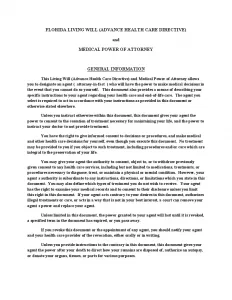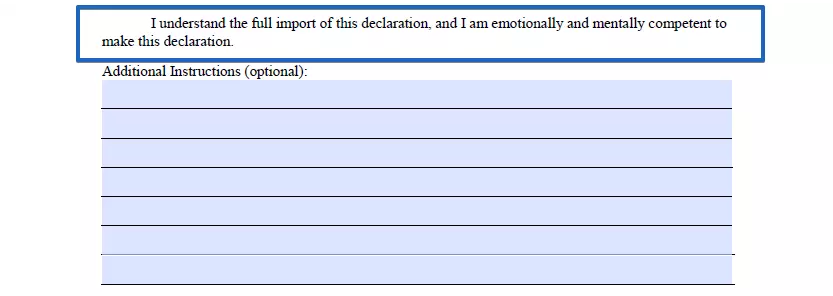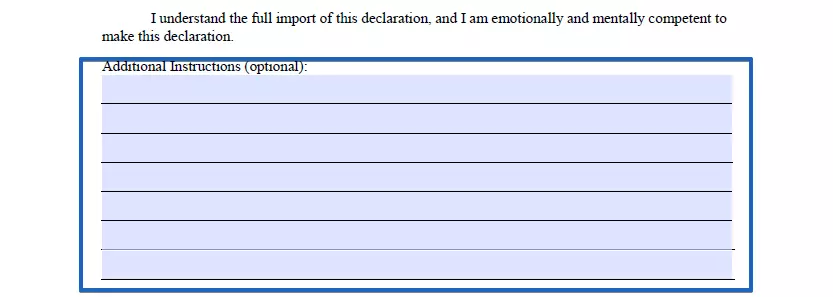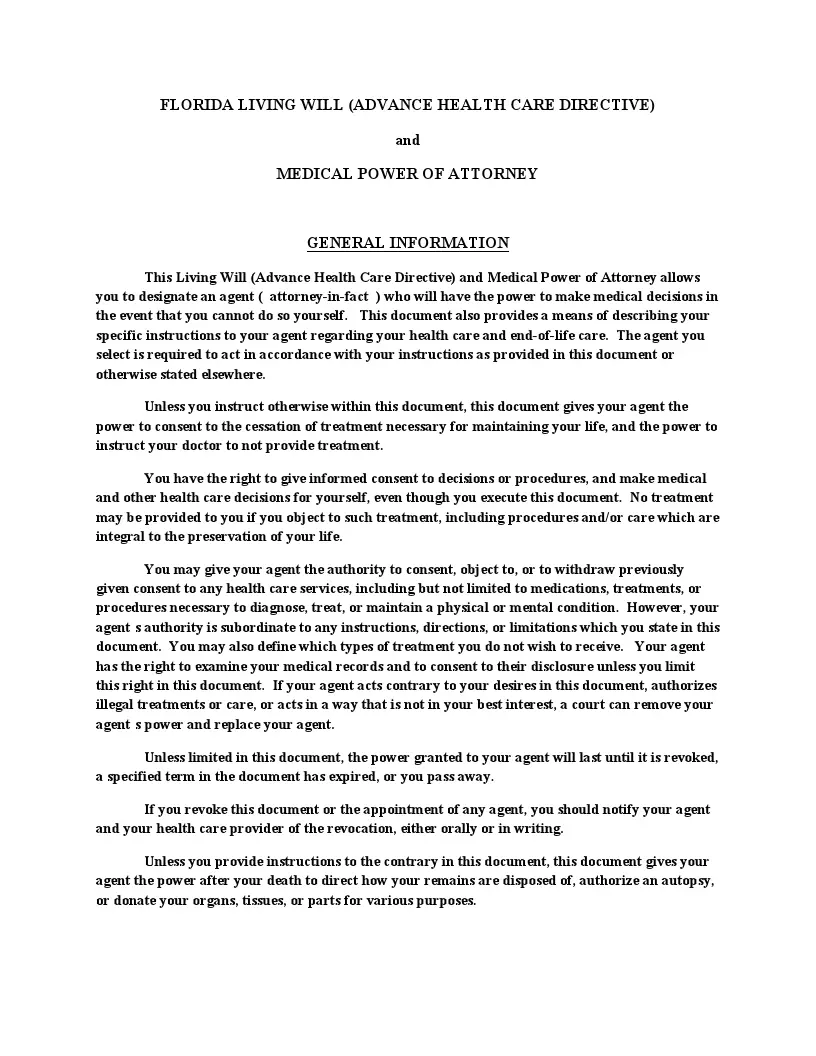Free Florida Living Will Form
The Florida Living Will form is a type of legal document that is applied when an individual cannot make a decision or communicate their decision about how they should be treated in case a life-threatening medical condition arises. It only covers health-related issues and must always be signed by two witnesses.
If you decide that you no longer want the form to be active if a medical condition arises, you can withdraw the living will form. It is only possible if the person withdrawing the form is determined to be in the right state of mind and can clearly make a decision about the withdrawal.
Section §765.303 of the Florida Statutes, the statutory laws of Florida, defines that if there is no active living will, the decisions regarding the patient’s health may be delegated to a guardian who had previously been appointed by the court. In case there is no such person, other people may assume this role. It is normally the spouse, child, parent, or another person (see the relevant section for a full ordered list).
Signing Requirements and Laws
When a person is signing the will, they essentially state how they want their health care decisions to be made if they cannot make them or express them. Health care decisions covered by a living will include:
- All forms of consent to medical care (including the withdrawal of such consent).
- The decisions about using (and applying for) benefits to cover the health care provision costs.
- Accessing the necessary information and records. If additional information may help make decisions on health-related matters or decisions about accessing the benefits, it is included in health care decisions covered by the will.
Section §765.302 of the Florida Statutes states that any competent adult can make a living will. According to the same section, a living will in Florida is applicable when one of the following happens to the person who had created the living will:
- they have a terminal condition,
- they are in a persistent vegetative state (PVS),
- they have an end-stage condition.
As the person signing the will, you need to understand these definitions well as they will be covered in the living will. Even though the terms are described in the Florida Statutes, the person itself, their surrogate (the person who will be deciding on their behalf), and doctors may have different interpretations of these conditions.
Two adults (at least 18 years old) witnesses must sign the written declaration of the will. At least one of the witnesses should not be a spouse or a blood relative to the creator of the living will. The witnesses also cannot be assigned as surrogates.
Florida Living Will Form Details
| Document Name | Florida Living Will Form |
| State Form Name | Florida Living Will |
| Signing Requirements | Two Witnesses |
| Validity Requirements | Section 765.302(1) |
| Powers Limitation | Section 765.303 |
| Avg. Time to Fill Out | 13 minutes |
| # of Fillable Fields | 48 |
| Available Formats | Adobe PDF; Microsoft Word |
| State Laws: Florida Statutes, Sections 765.301 to 765.309 | |

Steps to Fill Out the Form
To create a living will form, you must follow these steps:
1. Download the form
On our website, use our Online Forms Building Software to fill out the Florida Living Will form without mistakes.
2. Provide essential information
First of all, you need to fill in the date and provide your name.

3. Initial the criteria for when the will is to be implemented
You need to define the circumstances when the will is applicable, as we discussed above, and initial the document here to confirm that you understand when they will be implemented.

4. Define the actions that should be taken if there can be no recovery
Describe what should be done if medical professionals (define who specifically) determine that there is no recovery out of this state.

5. Assign a surrogate
Decide who will be your surrogate (they can also be called “a proxy,” and it is a person who you name as your representative). Surrogates can access information regarding your treatment or other information required for, for example, covering its costs, and they can make decisions on your behalf. The Florida Statutes include a section that states the right to choose an alternate surrogate. This option exists so that if the original surrogate cannot perform their duties, another person can take over.

6. Confirm that you are in the right state of mind
Explicitly state that you are emotionally and mentally competent to make these decisions.

7. Add other instructions (this step is optional)
You can state other desires or make other comments, such as asking your family members to treat your will with respect, for example, in this part of the form.

8. Sign the form
After all the instructions have been explicitly stated in the document, provide your signature. Remember that you need to state your full name at the beginning of the document, put your initials next to each of the criteria described above (terminal condition, PVS, or an end-stage condition), and sign at the bottom of the form.

9. Ask witnesses to sign the form
The witnesses need to provide their full names, signatures, home addresses, and phone numbers.


Below are other Florida templates filled out by FormsPal users. Consider our simple builder to customize any of these forms to your requirements.

